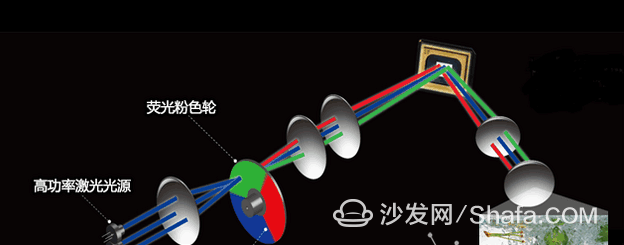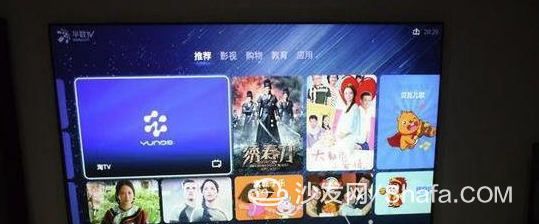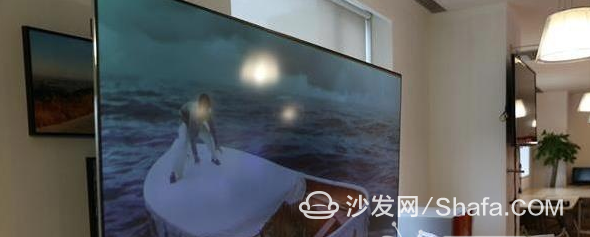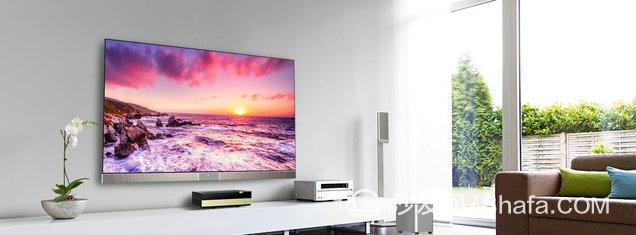Many friends are always tangled in decorating their new homes. Is it a big size TV or a laser TV when setting up the living room? From the home design point of view, perhaps the TV is an essential standard for the living room, or else a wall opposite the sofa will always feel strange where it is wrong, and from the viewing experience, some film lovers are biased In the larger size of laser TV products, as a hot television product in recent years, the actual effect of laser television, what is the significance of consumers to buy it?

Is laser TV worth buying?
As the audio-visual center for entertainment in the living room of a home, TVs from the initial black and white, to the CRT, went through a rear projection, plasma flashes, and then LCD dominated the market. Quantum dots, OLEDs, and laser televisions are now appearing. People are pursuing bigger and clearer images. The desire for television products is endless. When large-size TV products are too expensive, and traditional projectors have lethal display problems such as lamp life, projection brightness, and the like, laser projection TVs are taken as a novel solution by the manufacturers to the table.

Laser TV has a more immersive visual experience
In fact, laser television has already had a technical prototype as early as the 1990s. In 2006, Mitsubishi launched a 40-inch laser TV prototype. In 2007, Sony again launched a high-profile launch of a 60-inch laser TV prototype. At the 2007 International Consumer Electronics Show, Sony and Mitsubishi respectively showed A 55-inch, 40-inch laser TV prototype was produced. However, due to poor sales, technical bottlenecks and other reasons, several international electronics giants have withdrawn from the laser TV market. However, on the other hand, domestic manufacturers have suddenly made headway in the laser television market. They have all laid out R&D. From this year's IFA Electronics Show in Germany, it can be seen that several domestic large companies like TCL, Changhong, and Hisense have demonstrated The latest laser television products.
Can you really capture the hearts and minds of consumers? It is understood that laser televisions use laser as the light source and use reflective ultra-short focal projection technology to project light onto a special metal screen projector. Can achieve 100-inch large screen, enhance the presence of sense; gamut coverage theoretically up to 90% of the human gamut, the screen is more real, more layered and more transparent. But is this really the case?
Laser TV is a projector?
Before discussing this issue, it is necessary for us to first understand what laser television is. The working principle of laser television is actually very easy to understand. It consists of a laser, an optical deflector, and a screen. The laser television is mainly composed of a laser, an optical deflector and a screen, and generates R (red), G (green), B (blue) continuous, three-wavelength laser light sources, and controls the R, G, B laser scanning images through television signals. . To put it plainly, laser television is a projector that uses a laser as a light source.

Laser TV display principle
The reason why I dare to call TV is mainly because of its ultra-short-focus projection characteristics. Laser TVs have a small footprint and are projected almost vertically, so the projection ratio is very small, and the host can project almost 100 inches or more under the screen. Big picture. Laser TVs will be equipped with special screens, stereos, and some supporting facilities, with their own system UI, content with audio and video program sources, these features can also be called TV products.

Laser TV has fuselage system UI and content resources
At present, the laser TV products on the market are actually the same as the projectors in terms of structure, but the advantage of laser TVs is still obvious compared to the traditional projection products. After a certain period of time, the traditional projection equipment will appear dark and yellow. The brightness, color saturation, and contrast are significantly reduced. The laser television product uses the laser as the light source, which greatly improves the brightness and the life. And the biggest drawback of traditional projection products is that they have a single function, while laser televisions have a wealth of content resources to meet the daily visual and audio requirements of users.
The display effect is not as good as the LCD?
The vast majority of laser TV products currently on the market use single-chip DLP projection technology, which means that the image signal is digitally processed first, and then the light is projected. Light sources play a decisive role in the imaging of DLP technology. Theoretically, the laser light source can achieve a very high level of performance in the color gamut, but it refers to an RGB laser light source. However, it is limited by the cost and technology. Currently, most laser television products use monochromatic lasers as the light source. The color separation with phosphor color wheel is not ideal for the breadth of the color gamut. The actual color has its own backlight capability. Compared with LCD TVs, there are still gaps.

The actual color is not ideal
Laser television products are currently affected by the influence of ambient light. Although compared with the traditional projection equipment, the advantages of resisting ambient light are more obvious. In fact, the problem of dimming the brightness of the laser TV is still obvious. After all, it is not self-luminous. The greater the size, the greater the loss of light. Backlit LCD TVs still have a certain disadvantage. In addition, due to the special reflective principle of the panel, the viewing angle of the laser television cannot achieve a wide-angle viewing angle like a liquid crystal television. After a certain angle, the effect on brightness and visibility is significantly reduced.

After a certain angle, the effect is reduced in brightness and visibility
Many consumers purchase laser televisions to a large extent that they have a size of one hundred inches or more. Traditional LCD TVs have relatively small screen sizes. Seventy to eighty inches are already the limiting size of mainstream large screen products. Seven or eight million, more than one million, the price of laser television does have a great advantage, but not the bigger the size, the better, for example, watching the distance too close, easily lead to the user's visual fatigue, and the screen will produce a slight Grainy, it becomes less real. So consumers should also consider the size of their own living room space when they buy.

Laser TV giant screen, immersive, are their advantages
Written at the end:
Laser TV's giant screen, immersive, and cost-effective, are not small advantages, but at this stage, the technology is still not perfect, the market price is still high for the average family, the other body position and screen Can not move freely, otherwise there will be screen trapezoidal distortion, these factors have constrained the development of laser television. Whether it is traditional LCD TVs or laser TVs, consumers should consider their own needs when shopping, and they are the right choice for themselves.

Is laser TV worth buying?
As the audio-visual center for entertainment in the living room of a home, TVs from the initial black and white, to the CRT, went through a rear projection, plasma flashes, and then LCD dominated the market. Quantum dots, OLEDs, and laser televisions are now appearing. People are pursuing bigger and clearer images. The desire for television products is endless. When large-size TV products are too expensive, and traditional projectors have lethal display problems such as lamp life, projection brightness, and the like, laser projection TVs are taken as a novel solution by the manufacturers to the table.

Laser TV has a more immersive visual experience
In fact, laser television has already had a technical prototype as early as the 1990s. In 2006, Mitsubishi launched a 40-inch laser TV prototype. In 2007, Sony again launched a high-profile launch of a 60-inch laser TV prototype. At the 2007 International Consumer Electronics Show, Sony and Mitsubishi respectively showed A 55-inch, 40-inch laser TV prototype was produced. However, due to poor sales, technical bottlenecks and other reasons, several international electronics giants have withdrawn from the laser TV market. However, on the other hand, domestic manufacturers have suddenly made headway in the laser television market. They have all laid out R&D. From this year's IFA Electronics Show in Germany, it can be seen that several domestic large companies like TCL, Changhong, and Hisense have demonstrated The latest laser television products.
Can you really capture the hearts and minds of consumers? It is understood that laser televisions use laser as the light source and use reflective ultra-short focal projection technology to project light onto a special metal screen projector. Can achieve 100-inch large screen, enhance the presence of sense; gamut coverage theoretically up to 90% of the human gamut, the screen is more real, more layered and more transparent. But is this really the case?
Laser TV is a projector?
Before discussing this issue, it is necessary for us to first understand what laser television is. The working principle of laser television is actually very easy to understand. It consists of a laser, an optical deflector, and a screen. The laser television is mainly composed of a laser, an optical deflector and a screen, and generates R (red), G (green), B (blue) continuous, three-wavelength laser light sources, and controls the R, G, B laser scanning images through television signals. . To put it plainly, laser television is a projector that uses a laser as a light source.

Laser TV display principle
The reason why I dare to call TV is mainly because of its ultra-short-focus projection characteristics. Laser TVs have a small footprint and are projected almost vertically, so the projection ratio is very small, and the host can project almost 100 inches or more under the screen. Big picture. Laser TVs will be equipped with special screens, stereos, and some supporting facilities, with their own system UI, content with audio and video program sources, these features can also be called TV products.

Laser TV has fuselage system UI and content resources
At present, the laser TV products on the market are actually the same as the projectors in terms of structure, but the advantage of laser TVs is still obvious compared to the traditional projection products. After a certain period of time, the traditional projection equipment will appear dark and yellow. The brightness, color saturation, and contrast are significantly reduced. The laser television product uses the laser as the light source, which greatly improves the brightness and the life. And the biggest drawback of traditional projection products is that they have a single function, while laser televisions have a wealth of content resources to meet the daily visual and audio requirements of users.
The display effect is not as good as the LCD?
The vast majority of laser TV products currently on the market use single-chip DLP projection technology, which means that the image signal is digitally processed first, and then the light is projected. Light sources play a decisive role in the imaging of DLP technology. Theoretically, the laser light source can achieve a very high level of performance in the color gamut, but it refers to an RGB laser light source. However, it is limited by the cost and technology. Currently, most laser television products use monochromatic lasers as the light source. The color separation with phosphor color wheel is not ideal for the breadth of the color gamut. The actual color has its own backlight capability. Compared with LCD TVs, there are still gaps.

The actual color is not ideal
Laser television products are currently affected by the influence of ambient light. Although compared with the traditional projection equipment, the advantages of resisting ambient light are more obvious. In fact, the problem of dimming the brightness of the laser TV is still obvious. After all, it is not self-luminous. The greater the size, the greater the loss of light. Backlit LCD TVs still have a certain disadvantage. In addition, due to the special reflective principle of the panel, the viewing angle of the laser television cannot achieve a wide-angle viewing angle like a liquid crystal television. After a certain angle, the effect on brightness and visibility is significantly reduced.

After a certain angle, the effect is reduced in brightness and visibility
Many consumers purchase laser televisions to a large extent that they have a size of one hundred inches or more. Traditional LCD TVs have relatively small screen sizes. Seventy to eighty inches are already the limiting size of mainstream large screen products. Seven or eight million, more than one million, the price of laser television does have a great advantage, but not the bigger the size, the better, for example, watching the distance too close, easily lead to the user's visual fatigue, and the screen will produce a slight Grainy, it becomes less real. So consumers should also consider the size of their own living room space when they buy.

Laser TV giant screen, immersive, are their advantages
Written at the end:
Laser TV's giant screen, immersive, and cost-effective, are not small advantages, but at this stage, the technology is still not perfect, the market price is still high for the average family, the other body position and screen Can not move freely, otherwise there will be screen trapezoidal distortion, these factors have constrained the development of laser television. Whether it is traditional LCD TVs or laser TVs, consumers should consider their own needs when shopping, and they are the right choice for themselves.
For Oil Immersed Power Transformer, we can produce voltage from 35kV to 500kV, capacity upto 460MVA. We use the best quality of raw material and advance design software to provide low noise, low losses, low partial discharge and high short-circuit impedance for power transformer.
Our power transformer are widely used in national grid, city grid, rural grid, power plant, industrial and mining enterprise, and petrochemical industry.
Cast Resin Transformer,Power Transformer,Renewable Transformer,Power Transformer With Oltc
Hangzhou Qiantang River Electric Group Co., Ltd.(QRE) , https://www.qretransformer.com